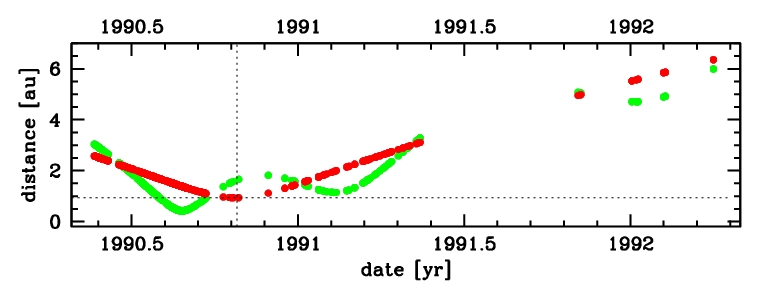| Solar System Dynamics & Planetology Group |
 |
C/1990 K1 Levy |  |
| Solar System Dynamics & Planetology Group |
 |
C/1990 K1 Levy |  |

| number of observations | 678 |
| number of residuals | 1321 |
| data interval | 1990 May 21 — 1992 Apr. 1 |
| rms [arcsec] | 0.95 |
| orbit quality class | 1b |
| Epoch (TT) | 19901105.0 | = JD 2448200.5 |
| time of perihelion passage (TT) | 19901024.684234 | ± 0.000102 |
| perihelion distance | 0.93869530 | ± 0.00000199 |
| eccentricity | 1.00038579 | ± 0.00000931 |
| argument of perihelion [deg] | 242.665901 | ± 0.000117 |
| longitude of the ascending node [deg] | 139.364541 | ± 0.000033 |
| inclination [deg] | 131.582128 | ± 0.000062 |
| inverse semimajor axis [10-6 au-1] | -410.98 | ± 9.91 |
| Nongravitational parameters [10-8 au/day2] | A1 = 3.694 ± 0.163 | A2 = -0.0736 ± 0.0769 | A3 = 0.3001 ± 0.0122 |
| time shift of g(r) relative to perihelion [day] | 5.3 ± 1.7 |
| Epoch (TT) | 16910715 | |
| time of perihelion passage (TT) | 19901024.553182 | ± 0.000176 |
| perihelion distance | 0.93928599 | ± 0.00000288 |
| eccentricity | 0.99989327 | ± 0.00000570 |
| argument of perihelion [deg] | 242.645221 | ± 0.000316 |
| longitude of the ascending node [deg] | 139.298604 | ± 0.000026 |
| inclination [deg] | 131.574011 | ± 0.000071 |
| inverse semimajor axis [10-6 au-1] | 113.63 | ± 6.07 |
| Epoch (TT) | 22800707 | |
| time of perihelion passage (TT) | 19901025.272025 | ± 0.000166 |
| perihelion distance | 0.93077116 | ± 0.00000836 |
| eccentricity | 1.00072380 | ± 0.00000434 |
| argument of perihelion [deg] | 242.432502 | ± 0.000464 |
| longitude of the ascending node [deg] | 139.316414 | ± 0.000040 |
| inclination [deg] | 131.505802 | ± 0.000062 |
| inverse semimajor axis [10-6 au-1] | -777.63 | ± 4.66 |